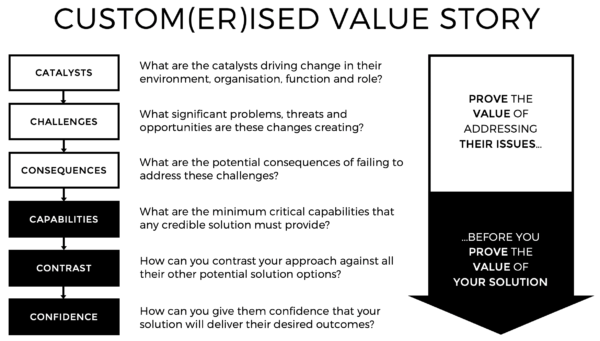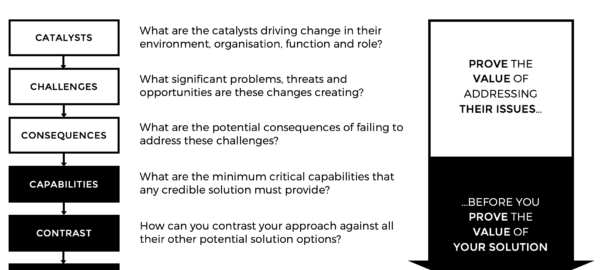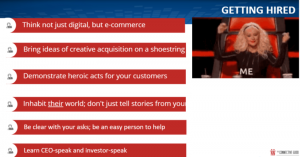— May 17, 2019

The best salespeople and the best content marketers are often great storytellers. They have the ability to craft compelling narratives that persuade their potential customers to want to buy.
But can the same story architecture work at both the macro (market-wide vision) and micro (specific customer value) level? The two-story types clearly need to be related but my experience suggests that there are some important differences…
Your vision story is a consistently-communicated message that is intended to resonate with your target audience and to articulate how your approach to solving that market’s most common challenges sets you apart from their other options. It is intended to attract suitable prospects and to make them want to engage with you.
Your value story, on the other hand, needs to be tailored to the particular circumstances of specific prospects, and can only be effectively told after you have undertaken one or a series of discovery and validation conversations. It is intended to confirm how you intend to deliver specifically relevant value to them via your solution.
Let’s look at the structure of these two story types:
Vision story structure
Andy Raskin is widely regarded as the leading exponent of the modern vision story and has helped many rapidly growing companies to nail their distinctive and compelling message. His clients have enjoyed great success with the following structure:
1: Start by naming a big, relevant change in the world
The last thing you want to do is to start your vision presentation by talking about your product, company, office locations, clients, awards or anything about yourself. Whilst these validations will ultimately be important if and when the prospect gets around to seriously evaluating your suitability as a supplier, they are boring barriers to initial engagement.
Instead, start by homing in on and naming an undeniable shift in your prospective customer’s world that – once the implications are fully understood – will cause them to recognize that they need to take urgent action. The change you have chosen will inevitably have consequences and create both threats and opportunities.
2: Show that there will be winners and losers
These threats and opportunities will, in turn, create winners and losers. You need to focus your prospect’s attention on the idea that the way in which they choose to deal with the identified change will have significant implications for their current and future business success.
It’s worth starting with the threats. According to leading behavioral economist Daniel Kahneman, all potential buyers suffer from “loss aversion”. They are 2-3 times more likely to respond to the fear of a threat than they are to the hope of a future opportunity. The more contrast you can create, the more likely they are to recognize the need for action.
3: Tease the Promised Land
You need to avoid the temptation to pitch your product or service at this stage. Instead, you need to introduce a vision of the Promised Land – what the prospect can achieve by dealing with the change in an effective way. You need to lead towards, rather than with, your solution.
The Promised Land represents their Desired Future State, not your solution – but it needs to be difficult to achieve without the sort of external help, experience and expertise you can provide. Creating a strong and credible contrast between their current situation and this desired future state further reinforces the case for action.
4: Introduce key capabilities as obstacle busters
You have now established the perfect platform to introduce your product or service. You need to carefully position a few of your most powerful (and preferably unique) capabilities as ways of eliminating the obstacles that would otherwise prevent or delay your customer from reaching the promised land.
By focusing on a few key themes, rather than on a long list of product features, you can differentiate your approach from the other options your customer may be considering – and position your competition as anchors that are more likely to hold their customers back in the past than to lead them towards your prospect’s desired future state.
5: Present evidence you can make the story come true
You’ve accurately and realistically identified the path to the promised land as being strewn with obstacles, so your prospect will justifiably be skeptical about any organization’s ability to deliver. This is where testimonials and references from your existing customers can be so powerful.
And even if – given the early stage of your market – these references are thin on the ground, demonstrating your solution as a series of “before and after” scenarios (rather than showcasing a list of unrelated features) can help to powerfully establish your credibility.
Everybody needs to sing from the same hymnbook
For this approach to be most effective, everyone in your organization – whether communicating to the market or responding to a “what do you do?” question – needs to be able to articulate and reinforce the same common vision. Whether in the form of your website, your demand generation campaigns, your CEO’s presentation at a conference or an individual sales person’s conversation with a customer, everyone needs to be on the same page.
Let’s imagine (not too hard to do, I hope) that your consistent and compelling vision story has attracted the active interest of a prospect who is a good fit against your ideal customer profile criteria. How can you make the story specifically relevant to them?
Value story structure
That’s where your value story structure comes in. Unlike your high-level vision story, which is consistently told to a wide audience of prospective customers – perhaps with suitable modifications for their particular vertical markets, your customer-specific value story is designed to help a particular potential customer to he how you can create value that is specifically relevant to their situation.
As you would expect, many of the themes are consistent with your high-level vision story, but they are structured in a slightly different way so that you can customize the elements to reflect your specific prospect’s current situation and desired future state.

1: Catalysts
What are the catalysts for change in the customer’s specific environment? They are likely to include the big, relevant changes in their world, but will also probably include external triggers which may include new legislation or regulation, competitive activity and other changes in the markets they are focused on.
The catalysts may also be internal, such as a recent change in executive leadership, new corporate priorities or initiatives, or the recognition that an existing initiative is not achieving its desired objectives. The key here is to identify one or a number of customer-specific (and customer-acknowledged) catalysts for change.
2: Challenges
These customer-specific catalysts will create customer-specific challenges. These can take the form of problems, issues, opportunities or threats that – if not successfully addressed – have the potential to do harm to the business.
Some of these challenges will already be obvious to the prospect, but they may be underestimating them. We can help guide their thinking by introducing additional challenges that our accumulated experience suggests may also be relevant to them.
3: Consequences
These challenges inevitably carry consequences. They may expose the prospective customer to lost revenue, unnecessary cost, wasting precious time, failing to achieve key goals, avoidable risk, reduced productivity and/or reputational damage.
We need to identify (and get the customer to acknowledge) the most serious consequences – which could be at the organizational level, at the departmental or functional level, and/or at the key individual stakeholder level.
Together, these catalysts, challenges and consequences provide the justification for taking action and allow us to pivot to explain how we can create specific relevant value for the customer whilst helping them evolve from their current situation to a clearly-defined desired future state.
4: Capabilities
This is now a great place to introduce (and help the customer to acknowledge) the key capabilities that any credible solution will need to deliver. Of course, we are choosing to highlight capabilities that we are particularly good at delivering and which their other options will find difficult to provide.
Effectively, we are seeking to shape their “vision of a solution”, and with good reason. Research by Forrester and others has shown that the vendor that does the most to shape the prospect’s vision of a solution has a win rate that is at least 3 times higher than the other options under consideration.
5: Contrast
We’re now in a position to really nail down the contrast between our approach and all the other options they may be considering in the context of the prospect’s specific current situation and desired future state.
And while we are at it, we might as well reinforce the contrast between the consequences of sticking with their current and the potential benefits of moving to their desired future state.
6: Proof
Finally, our prospective customer will be looking for proof – but rather than our general success stories, we will want to show them how our approach is going to deliver specific positive outcomes for them, as it has done for other similar organizations facing similar challenges
In conclusion
I hope you’ll agree with me that we need both a widely-told vision story and a framework for creating a customer-specific value story. The latter requires that we invest in excellent discovery, but it means that our carefully-tailored story is going to be that much more relevant to each specific customer.
At least that’s my story, and my experience. What’s your perspective?
Business & Finance Articles on Business 2 Community
(75)
Report Post






